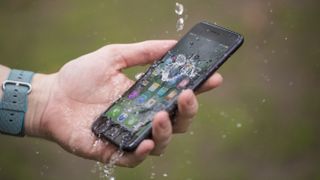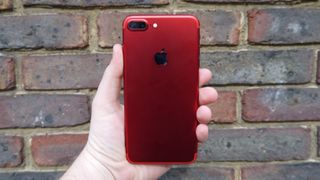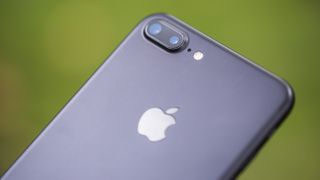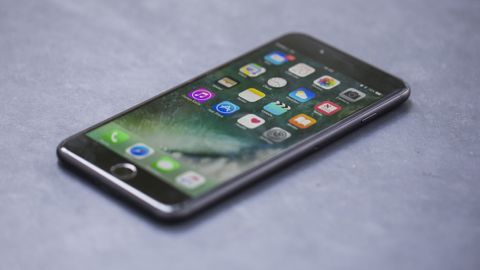TechRadar Verdict
Apple's iPhone 7 Plus offers a familiar 5.5-inch display and marked design changes, both good and bad. It launched a new home button pad, a waterproof design, and no headphone jack. Its portrait photos are a big selling points, as is its price next to the newer iPhone XS and iPhone 8.
Pros
- +
Powerful for its price
- +
Excellent camera
- +
Solid battery life
Cons
- -
No headphone jack
- -
Screen still only Full HD
Why you can trust TechRadar
The iPhone 7 Plus is now the cheapest large-screen iPhone that Apple still sells, so it remains a popular choice despite being replaced twice-over by the iPhone 8 Plus and then the even bigger display of the modern Apple flagships, culminating in the latest iPhone 12 Max.
Moreover, it's updated with all the perks of iOS 14, including widgets, Dark Mode, and a host of app upgrades, giving it all the software in the priciest flagship iPhones.
Even though its traditional iPhone design won't wow you in 2021, the 7 Plus did bring about a new Touch ID home button pad with no moving parts and a water-resistant design that will give you peace of mind. It's less breakable than previous iPhones, especially if you pair it with an iPhone 7 Plus case.

Weight: 188g
Dimensions: 158.2 x 77.9 x 7.3mm
OS: iOS 12 (or iOS 13 beta)
Screen size: 5.5-inch
Resolution: 1080 x 1920
CPU: Apple A10 Fusion
RAM: 3GB
Storage: 32/128/256GB
Battery: 2,900mAh
Rear camera: 12MP
Front camera: 7MP
It's also been heavily discounted since it launched, making the iPhone 7 Plus one of the most affordable Apple phones to run the latest iOS 14. While no longer sold directly by Apple, you can still buy the iPhone 7 Plus at plenty of retailers.
But it's missing something significant: a 3.5mm headphone jack. The iPhone 7 series was the first without this standard way of plugging in headphones. Apple AirPods did come along to help alleviate this problem, at least to some degree.
Why do we recommend the iPhone 7 Plus over the standard iPhone 7? Two reasons other than the bigger screen size: improved battery life and an innovative camera.
Battery is always going to be better on a bigger phone, given the larger capacity, but the camera was a surprise at launch. Apple added a dual-lens camera, a conscious effort to make the iPhone 7 Plus a distinctly different choice.
The 7 Plus is the better of the two 2016 iPhones, even if it hasn't moved in leaps and bounds from the overall iPhone 6S Plus look, and it's cheaper than the iPhone XR if you're on a budget. Make sure to compare prices with the new iPhone SE 2020, which is physically identical but has a far more current chipset (and thus will get iOS updates for years longer).
iPhone 7 Plus price and availability
- iPhone 7 Plus price (32GB): $569 (£569, AU$929)
- iPhone 7 Plus price (128GB): $669 (£669, AU$1,099)
- Launch price: from $769 (£719, AU$1,229)
- iPhone 7 Plus release date: September 2016
At launch, the iPhone 7 Plus price started at $769 (£719, AU$1,229) for the entry-level 32GB model and $869 (£819, AU$1,419) for the 128GB variant. Apple also offered a 256GB iPhone 7 Plus, but this particular model has now been discontinued.
With the arrival of newer generations of iPhone, the iPhone 7 Plus price has dropped, and it can now be picked up for $569 (£569, AU$929) in its 32GB guise.
Meanwhile, the 128GB iPhone 7 Plus price is down to $669 (£669, AU$1,099).
The iPhone 7 Plus is still widely available from Apple directly and from major retailers and carriers around the world.

Duplicate design
- Water resistance is genuinely useful
- Lack of a headphone jack is initially frustrating
- More of the same design, with the same look as predecessors
It's easy to tell the iPhone 7 Plus apart from its predecessors, as it's the only iPhone to sport two cameras on its rear.
Aside from the bulkier camera block, lack of a headphone port (more on that in a minute) and a couple of new colors though, Apple's stuck with exactly the same design that's served it well for its previous two iPhone iterations.
If you've owned, or are familiar with, the iPhone 6 Plus or 6S Plus then you'll know exactly what the iPhone 7 Plus looks like.
The rounded corners, aluminum frame and minimalist styling means the iPhone 7 Plus retains its premium status, and with the introduction of new black and 'jet black' colors, fans have two new ways to show their dark side.
More recently, Apple introduced a special edition red version of the iPhone 7 Plus (and iPhone 7) in partnership with the Global Fund to support HIV/AIDS programs and help deliver an AIDS-free generation - though only the black, silver, gold and rose gold shades are still sold direct from Apple.

We've used the red version of the iPhone 7 Plus now and found most people who have seen it like the look of the phone, but no-one we've spoken to has been thrilled enough to jump out of their seats to buy the phone in red immediately.
If you're curious about the shiny jet black finish, check out our iPhone 7 review, but if you're interested in the standard black color then stay right here.
We're fans of this matte black finish, as it gives the iPhone 7 Plus an understated yet elegant look – basically the polar opposite to the gaudy rose gold that's also an option here.

Moving on to the lack of a headphone jack, it's a decision Apple has described as "courageous", but while it's a positive step forward for the mobile industry, the short-term effects are the ones that are making the most noise for now.
- Here's what comes in the box when you buy the iPhone 7 Plus
Apple does include an adapter in the iPhone 7 Plus box, allowing you to plug in your standard 3.5mm headphone connection – but it's not a particularly appealing compromise. It also includes a set of lightning-connected EarPods, so you can avoid the adapter if you don't mind Apple's creations – but immediately there's a problem.

If you're someone who tends to find themselves charging their iPhone while also listening to music via a pair of wired headphones, that's a no-go with the iPhone 7 Plus. It's one or the other – unless you use an adaptor that's rather unattractive, and which you'll have to purchase separately.
The easy way around this is to invest in a set of wireless headphones – Apple's own AirPods are available for $159 (£159, AU$229) – but any Bluetooth set will work with the handset if you want to spend less.
It's far from a crisis at Apple, but the inconvenience is real – and it's one we experienced during our review – although it's one that can be easily overcome if you're willing to compromise a little.
A new feature that's much less controversial is the IP67 rating for the iPhone 7 Plus, meaning it's both dust-proof and water-resistant.

It'll be able to survive an accidental slip into the bath, or a quick email bashed out in the shower, with the official test showing it's good for a half-hour dip at a depth of up to one meter in freshwater.
It's worth noting that it's not fully waterproof though, and frequent exposure to water may well spell trouble – but the iPhone is now more capable than ever of surviving life's little accidents.
Measuring 158.2 x 77.9 x 7.3mm, the 7 Plus is exactly the same size as the 6S Plus it's replacing, although it has dropped slightly in weight, from 192g to 188g. For users looking to upgrade from the now two-year-old 6 Plus, the 7 Plus is slightly thicker, and still a little heavier than your current device.

You're unlikely to notice the difference in the hand though, as it'll still stretch your one-handed dexterity to the max, especially when it comes to hitting the back button in the top-left corner.
Apple's 'reachability' feature, while sees the top of the screen jump down to halfway with a double-tap of the home key, is still in play here, which helps alleviate the sheer height of the handset dictated by the Cupertino firm's now-iconic chunky bezels.
Bringing all this together, Apple has another well-styled iPhone on its hands, and while it hasn't broken any new ground in terms of looks, this is the most robust and refined handset we'd seen from the firm at the time, though numerous handsets from Apple and others have since improved upon it.

Researchers have used lasers on a material used in nuclear fuel to create a quasi-eternal data storage media — super-hard silicon carbide DVD-like discs could have a capacity of 677GB

Billions of Discord chats have been harvested, set to be sold online

Sign up for a Visible Wireless unlimited plan and pay just $275 a year - yes, really

